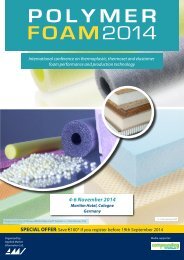Dissertations in Forestry and Natural Sciences
24lYKFN
24lYKFN
Create successful ePaper yourself
Turn your PDF publications into a flip-book with our unique Google optimized e-Paper software.
Taneli Väisänen: Effects of Thermally Extracted Wood Distillates on<br />
the Characteristics of Wood-Plastic Composites<br />
2.2.1 Mechanical properties<br />
Wood fibers are added to polymers to <strong>in</strong>crease their stiffness<br />
<strong>and</strong> strength (Wolcott <strong>and</strong> Englund 1999). The presence of wood<br />
fibers <strong>in</strong> the polymer matrix typically <strong>in</strong>creases the strength <strong>and</strong><br />
modulus of the composite (Bhaskar et al. 2012, Li et al. 2014).<br />
However, both the polymer matrix <strong>and</strong> the fiber re<strong>in</strong>forcement<br />
are responsible for the mechanical performance of the<br />
composite. Tensile strength is more sensitive to the properties<br />
of the polymer matrix whereas the modulus of elasticity of the<br />
composite is primarily dependent on the properties of the fiber.<br />
In order to <strong>in</strong>crease tensile strength, a strong fiber-matrix<br />
<strong>in</strong>terface, oriented fibers, <strong>and</strong> low stress concentration are<br />
required whereas the maximization of the tensile modulus<br />
requires fiber wett<strong>in</strong>g <strong>in</strong> the matrix phase, a high fiber<br />
concentration <strong>and</strong> fibers with a high aspect ratio. (Saheb <strong>and</strong> Jog<br />
1999)<br />
The fiber must have a certa<strong>in</strong> m<strong>in</strong>imum length, i.e., the<br />
critical fiber length, <strong>in</strong> order to achieve the fully stressed<br />
properties to the fiber <strong>in</strong> the polymer matrix (Stark <strong>and</strong><br />
Rowl<strong>and</strong>s 2003, Sa<strong>in</strong> <strong>and</strong> Pervaiz 2008). The critical length<br />
depends on the fiber characteristics <strong>and</strong> shear strength of the<br />
fiber-matrix bond. The fiber-matrix <strong>in</strong>terface is likely to fail due<br />
to the debond<strong>in</strong>g at lower stresses if the length of the fiber is less<br />
than its critical strength (Stark <strong>and</strong> Rowl<strong>and</strong>s 2003, Bourmaud<br />
<strong>and</strong> Baley 2007). By contrast, exceed<strong>in</strong>g the critical fiber length<br />
may reduce the strength of the composite because the effective<br />
stress transfer may be impaired due to fiber curl<strong>in</strong>g <strong>and</strong> fiber<br />
bend<strong>in</strong>g (Sreekumar et al. 2007).<br />
Interphase <strong>and</strong> <strong>in</strong>terface are two important concepts <strong>in</strong> fiberre<strong>in</strong>forced<br />
polymer composites. The <strong>in</strong>terface is a twodimensional<br />
surface between the fiber <strong>and</strong> the matrix whereas<br />
the <strong>in</strong>terphase is the three-dimensional <strong>in</strong>termediate between<br />
the matrix phase <strong>and</strong> the fiber phase (Pilato <strong>and</strong> Michno 1994,<br />
Oksman Niska <strong>and</strong> Sanadi 2008, Jesson <strong>and</strong> Watts 2012). The<br />
<strong>in</strong>terface <strong>in</strong> any fiber-polymer composite system is responsible<br />
for transmitt<strong>in</strong>g stresses from the matrix to the fibers, <strong>and</strong> the<br />
contribution of surfaces to stress transfer depends on both the<br />
34 <strong>Dissertations</strong> <strong>in</strong> <strong>Forestry</strong> <strong>and</strong> <strong>Natural</strong> <strong>Sciences</strong> No 222



